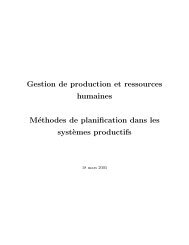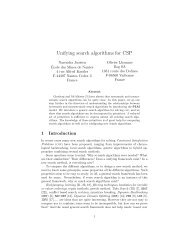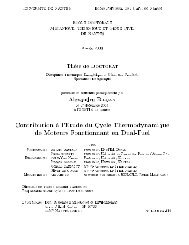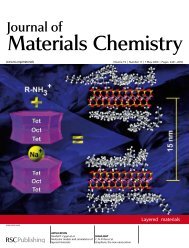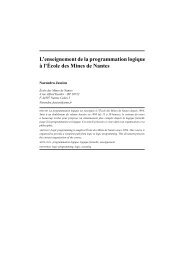pdf - 395 K - Ecole des mines de Nantes
pdf - 395 K - Ecole des mines de Nantes
pdf - 395 K - Ecole des mines de Nantes
You also want an ePaper? Increase the reach of your titles
YUMPU automatically turns print PDFs into web optimized ePapers that Google loves.
they often provi<strong>de</strong> implementation of middleware agents like FIPA’s DF and AMS for agentmanagement. Furthermore, most of agent platforms also provi<strong>de</strong> agent frameworks.Another interesting feature is the compliance of platforms with FIPA specifications. FIPA has<strong>de</strong>fined experimental specifications that are to evolve to become a standard. FIPA hasreleased three sets of experimental specifications until now: FIPA 97, FIPA 98 and FIPA2000, the last one making the others obsolete. Specification domains inclu<strong>de</strong> the abstractarchitecture, agent management, agent message transport system, communication languageand content language.The following software is non-commercial platforms for <strong>de</strong>veloping MASs.2.4.1 JADEJADE, the Java Agent DEvelopment Framework [57], was <strong>de</strong>veloped by Telecom Italia andthe University of Parma. It requires a Java 2 Runtime Environment and has been tested onmany platforms. The last version, 2.5, was released in February 2002. It complies with FIPA2000 specifications.JADE implements an agent platform and a <strong>de</strong>velopment framework. The platform can bedistributed over several hosts regardless of the OS. It also supports agent migration andcloning. Agents lifecycle can be controlled via a GUI that also supports <strong>de</strong>bugging.It is a complete, rather mature tool that has been successful. It can be exten<strong>de</strong>d with manyadd-ons. For example, JESS allows for the <strong>de</strong>velopment of rule-based behaviours. It alsosupports the Protégé ontology editor. Furthermore, many research prototypes have been basedon JADE.Lastly, JADE has been integrated with the LEAP project (Lightweight Extensible AgentPlatform) [58]. This project targets mobile enterprises and ensures compatibility with mobileJava environments down to J2ME-CLDC. Thus it aims at providing FIPA-compliant agentson PDAs and mobile phones.2.4.2 FIPA-OSFIPA-OS (FIPA Open Source) is an Open Source implementation of the FIPA standardoriginating from a research lab of Nortel Networks [Networks, #41][Forge, #42]. It provi<strong><strong>de</strong>s</strong>implementation for agent platforms and a component-based toolkit for <strong>de</strong>veloping domain<strong>de</strong>pen<strong>de</strong>ntagents. It is thus inten<strong>de</strong>d to enable rapid prototyping. FIPA-OS supports most ofthe recent FIPA experimental including the agent management and communication systems.Since its first release in 1999, it has been continuously improved as a managed Open Sourcecommunity project, leading to more than 10 formal new releases. Upgra<strong><strong>de</strong>s</strong>, bug fixes an<strong>de</strong>xtensions have been provi<strong>de</strong>d. In particular, a version of FIPA-OS aimed at PDAs andmobile phones, µFIPA-OS, has been <strong>de</strong>veloped by the University of Helsinki. In addition,useful tutorials are proposed as well as an active newsgroup.MSc EMOOSE Thesis – http://www.emn.fr/EMOOSE 20




